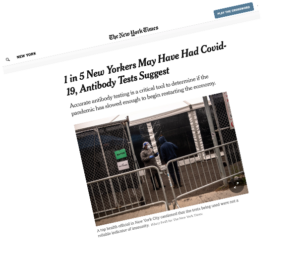A pharmacology professor of mine used to say, “All drugs are toxic, but some have helpful side effects.” Over the years I have found that to be a helpful lens. Your body evolved to ingest food and water. Everything else is meddling with your chemistry. Hydroxychloroquine is no exception. The malaria drug touted by everyone from the Chinese Government to a rogue French physician to Donald Trump might have helpful side effects. But it might just be another poison. Let’s consider the story.
It begins in January, as Chinese physicians and researchers are on the front lines of a battle with a new strain of an old virus and desperately testing everything they can find against the it. On February 4, a team of Chinese virologists published a paper evaluating the toxicity and the “helpful side effects” of six different drugs against the new virus in a laboratory grown culture of monkey cells. One did nothing, one killed the virus and the cells, and three demonstrated enough toxicity to worry about. But one inhibited the virus and had no toxic effect on the monkey cells at all. That was the malaria drug, chloroquine.
By the time that study came out, physicians in China had been giving the drug to patients for weeks. Just two weeks later, a second paper emerged, which mentioned, but did not provide results from, a clinical trial at 10 hospitals. The paper simply says, “results from more than 100 patients have demonstrated that chloroquine phosphate is superior to the control treatment in inhibiting the exacerbation of pneumonia, improving lung imaging findings, promoting a virus- negative conversion, and shortening the disease course”. On the basis of these unpublished results, which the authors called a “breakthrough”, they advocated making use of the drug part of standard protocol for treating the infection. A month and a half later, the data from that trial have yet to emerge. In Covid-time, seven weeks is an eternity.
The first clinical trial to emerge came not from China, but from France in late March. This paper describes a non-randomized clinical trial that seemed to show dramatic improvements in patients treated with a combination of Hydroxychloroquine (a standard form of chloroquine that is better tolerated) and an antibiotic (azithromycin). The first red flag here is the word, non-randomized. It means that the decision to give a patient either the drug or a placebo was not made by chance. In other words, something other than the drug could explain the different outcomes between groups. There is no guarantee, for example, that the investigators did not, perhaps even unconsciously, give the test drug to healthier subjects. Under ordinary circumstances, no journal would touch a non-randomized trial. But these are not ordinary circumstances.
Before that paper could even be published, two other papers came out criticizing its findings. One was a reanalysis of their data, which concluded that flaws in the clinical trial made it impossible to draw a conclusion and the other was a case series that “found no evidence of a strong antiviral activity or clinical benefit of the combination of hydroxychloroquine and azithromycin”.
Last week, a randomized clinical trial did emerge from China, but the investigators own data raise serious questions about exactly how randomized it was. Specifically, the control subjects had been experiencing fever and a cough for 50% longer than the cases. Their own analysis shows that there is less than a one in a thousand probability of that difference occurring by chance. In other words, either they had a wildly improbable data set, or the patients were not truly randomized.
To complicate matters a bit further, let’s return to that original cell culture. The problem with cell cultures is that they consist of a single cell type, which is isolated in a lab, as opposed to the hundreds of cell types all interacting and communicating with one another that comprise an actual human being. Hydroxychloroquine has toxic effects on cells of the eye and the heart and the immune system and even the skin, none of which was in that petri dish of monkey cells.
For now, we don’t know if this toxic drug has helpful side effects.
The truth will out. At the moment, there are some 58 clinical trials in process to test this treatment. But we need to get it right. Even when we are operating in Covid-time.



